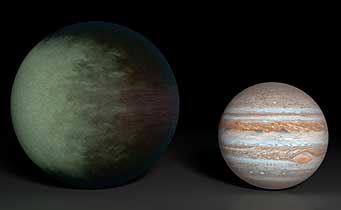Visible and infrared observations suggest that the hot Jupiter Kepler-7b has a large patch of clouds on one side.

This illustration compares a fanciful view of Kepler-7b (left) with Jupiter. Although Kepler-7b is about half again as wide as Jupiter, it's only about half Jupiter's mass. Gas giants that hug their stars as Kepler-7b does puff up a lot, potentially because of a current linking the star and planet.
NASA / JPL-Caltech / MIT
Despite our wild imaginings, exoplanets are still pretty mysterious. But astronomers are edging closer to understanding what these far-off worlds look like as planets, and not just pinpricks or blips in starlight. One recent study, appearing in the October 20th Astrophysical Journal Letters, explores the atmosphere of Kepler-7b and reveals what looks like a big patch of clouds.
Whether this study is the first map of exoplanet clouds depends on the distinction you draw between brown dwarfs and planets: last January astronomers reported they had teased apart atmosphere layers in the brown dwarf 2MASS J22282889?431026. And observers have found hints of “storms” on these failed stars, too. But the new study is still neat. Kepler-7b is about half Jupiter’s mass and whizzes around its 1.4-solar-mass star in less than 5 days, but it’s cooler than expected. The potential cloud cover might explain why.
You can read more about the results in the team’s detailed press release (the first paragraph of which is below), or in the paper itself.
From the MIT news office
Scientists generate first map of clouds on an exoplanet
On the exoplanet Kepler 7b, the weather is highly predictable, an international team of scientists has found: On any given day, the exoplanet, which orbits a star nearly 1,000 light-years from Earth, is heavily overcast on one side, while the other side likely enjoys clear, cloudless weather. . . .
(Well, it might still be hazy: it's a hot Jupiter, after all.)
 2
2
Comments
Bruce
October 8, 2013 at 8:49 am
Since Kepler 7b is in a tight, less than 5 day orbit, it would have to be tidally locked, right? I would assume so, so then is the cloudy side completely the same as the side that always bakes under the intense heat from its star? The illustration makes this appear to be the case.
You must be logged in to post a comment.
Camille Carlisle
October 10, 2013 at 2:08 pm
You're right, the planet is tidally locked. I think the cloud cover is slightly off-center from being exactly coincident with the heated side: the authors note in their abstract that "We therefore conclude that high altitude, optically reflective clouds located west from the substellar point are present in its atmosphere." What the cause of the offset (or even the clouds themselves) is remains unclear.
You must be logged in to post a comment.
You must be logged in to post a comment.